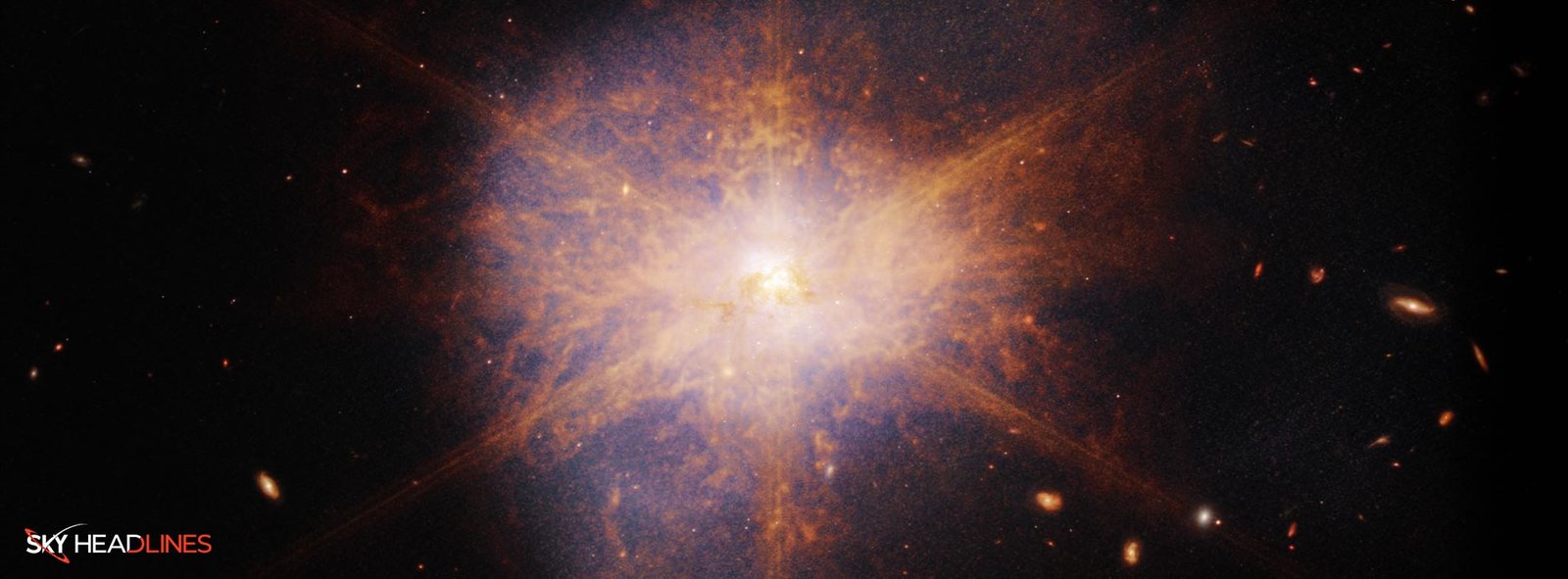The galactic merger of Arp 220, has recently been featured in a stunning image taken by NASA’s forthcoming James Webb Space Telescope. Arp 220 is an ultra-luminous infrared galaxy. It emits over a trillion suns’ worth of luminosity. This galaxy is a remarkable example of intense star formation. The collision of two spiral galaxies triggered this phenomenon. The collision began about 700 million years ago. It led to the formation of around 200 massive star clusters. The Webb telescope has released a new image of Arp 220. It shows faint tidal tails and organic material in streams and filaments. The image also reveals evidence of the ongoing galactic dance.
So let’s start by,
What is Arp 220?
Arp 220 is a 250 million light-years from Earth, in the constellation Serpens, is the ultra-luminous infrared galaxy (ULIRG). It is a spectacular merging pair of spiral galaxies that began colliding around 700 million years ago. As a result of this collision, approximately 200 large star clusters have formed and are located within a congested, dusty area spanning 5,000 light-years. Arp 220 shines in the light of more than a trillion suns and is the nearest ULIRG to us and the brightest of the three galactic mergers closest to Earth. The entire Milky Way galaxy’s worth of gas is visible in this minuscule area.
A huge explosion of star creation resulted from the collision of two spiral galaxies some 700 million years ago. As a result, a densely packed, dusty region formed, roughly 200 large star clusters spanning approximately 5,000 light-years. Furthermore, the collision between these two spiral galaxies created around 200 huge star clusters, starting some 700 million years ago. Additionally, the region measured 5,000 light-years across and was crowded and dusty. Notably, this small area contains as much gas as the entire Milky Way galaxy does.
The galaxy has been studied previously by radio telescopes, which revealed about 100 supernova remnants, and by NASA’s Hubble Space Telescope, which uncovered the cores of the parent galaxies. Webb recently captured Arp 220 with its Near-Infrared Camera (NIRCam) and Mid-Infrared Instrument (MIRI). The image reveals the stunning beauty of the galactic merger in infrared light. Moreover, the faint tidal tails and organic material in streams and filaments across Arp 220.
One more thing that might pop up in your head,
Has Arp 220 Been Captured Before? A Look at Past Observations of this Remarkable Object
The latest photo from the James Webb Space Telescope offers a new and intriguing view of Arp 220. This object has already been studied extensively in the past, but has remained a captivating subject for astronomers for many years. Arp 220 is one of the nearest and brightest examples of a galaxy experiencing a significant burst of star formation.
It is an extremely bright infrared galaxy that may be found around 250 million light-years away in the Serpens constellation. As a result, this object has attracted the attention of numerous telescopes over the years to solve its secrets.
The Hubble Space Telescope made a significant observation of Arp 220. This exposed an intricate web of filaments and bubbles in the galaxy’s surrounding gas and dust. This image also showed evidence of two merging galaxies at the center of Arp 220. This was later confirmed by subsequent observations.
Despite these earlier observations, the recent image captured by the James Webb Space Telescope provides a much clearer view of Arp 220 and reveals details that were previously unseen.
Now let’s discuss the,
Webb’s imaging of Arp 220:
NASA’s newest and most potent space telescope, the James Webb Space Telescope, beautifully depicted the Arp 220 cosmic collision between two spiral galaxies in a photograph. This stunning collision ignited a burst of star formation, resulting in a dazzling display of over a trillion suns shining in infrared light.
The Mid-Infrared Instrument (MIRI) and Near-Infrared Camera (NIRCam) on the Webb telescope caught this galaxy merger in unparalleled detail. A rotating ring of star formation surrounds each of the galactic cores. Which is emitting brilliant infrared light and produces a striking spiked starburst characteristic. The image shows blue tidal tails drawn off by gravity, revealing the galactic dance. It displays streams and filaments of reddish-orange colored organic material.
Lastly, let’s conclude this with,
Conclusion:
The James Webb Space Telescope’s amazing image gives us a peek at the breathtaking and awe-inspiring magnificence of our cosmos. It displays the impressive capabilities of this amazing observatory and what we might anticipate learning in the upcoming years. We may be certain that we will explore and uncover the beauty of space as long as we have space technology like JSWT.





